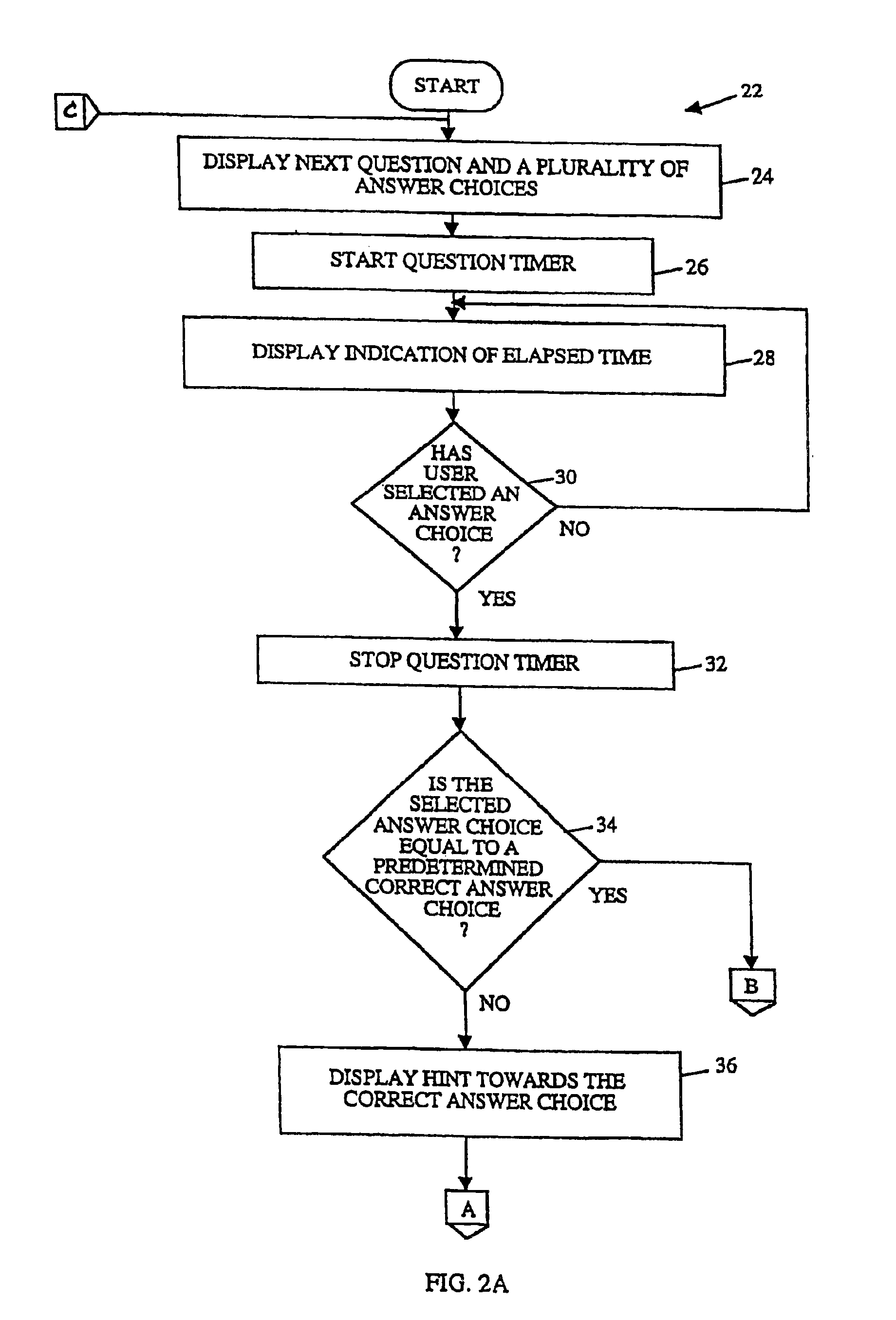Method and apparatus for improving performance on multiple-choice exams
a multiple-choice exam and performance improvement technology, applied in the field of computerized learning approach, can solve the problems of not being able to force the user to study in a consistent, systematic and effective way, and being a large time-consuming and laborious, and achieve the effect of improving performance on multiple-choice exams
- Summary
- Abstract
- Description
- Claims
- Application Information
AI Technical Summary
Benefits of technology
Problems solved by technology
Method used
Image
Examples
first embodiment
[0033]FIGS. 2A and 2B are block diagrams of a learning method according to the invention. The learning method 22 begins by displaying 24 a question and a plurality of answer choices to a user. For example, the question and its answer choices can be retrieved from the various practice questions 16 stored in the memory 10 and then displayed on the display screen 6. Preferably, the question and its answer choices are very similar to the questions and answers which actually appear on the MBE. It is also preferable that the questions and answers be displayed in a format and font which are very close to those used in the MBE. The closer the appearance and the format of the question and its answer to that of the MBE, the more comfortable the user will be on the actual MBE exam.
[0034]Once the question and its answer choices are displayed 24, a question timer is started 26. The question timer operates to keep track of the amount of time elapsed from the time the question was displayed until ...
second embodiment
[0050]FIG. 6 is a block diagram of a learning method according to the invention. The learning method 82 in this embodiment forces the user to indicate whether each of the answer choices is correct or incorrect. By forcing the user to consider all the answer choices, the learning method makes the user practice the problem-solving approach employed by most exam takers, namely to make an educated guess at the correct answer after eliminating answer choices known to be incorrect.
[0051]In any case, the learning method 82 begins by displaying a question and a plurality of answer choices. Next, the user chooses 86 one of the answer choices. The learning method 82 then asks the user to indicate 88 whether the chosen answer choice is the correct answer choice. Note, here the user can select any of the answer choices, not just the correct answer choice, and thereafter, indicate whether it is correct or incorrect.
[0052]If the user indicates that the selected answer choice is a correct answer, ...
third embodiment
[0055]FIGS. 7A and 7B are block diagrams of a learning method according to the invention. In this embodiment, the learning method 104 sequences through the answer choices prompting the user to indicate whether he / she believes the answer choice to be correct or incorrect. The user can also answer “unsure” if the user cannot make an educated guess at the present time.
[0056]The learning method 104 begins by displaying 106 a question and a plurality of answer choices to the user. Next, a selected answer (SA) is set 108 to “A”, indicating a first answer choice. The learning method 104 then prompts the user to decide 110 whether SA is the correct answer choice. If the user answers in the affirmative, then block 112 is performed. Block 112 represents blocks 90 and 94-98 shown in FIG. 6. On the other hand, if the user answers negatively, then block 114 is performed. Block 114 represents blocks 92-98 shown in FIG. 6. A third option is also available to the user. If the user is unsure as to w...
PUM
 Login to View More
Login to View More Abstract
Description
Claims
Application Information
 Login to View More
Login to View More - R&D
- Intellectual Property
- Life Sciences
- Materials
- Tech Scout
- Unparalleled Data Quality
- Higher Quality Content
- 60% Fewer Hallucinations
Browse by: Latest US Patents, China's latest patents, Technical Efficacy Thesaurus, Application Domain, Technology Topic, Popular Technical Reports.
© 2025 PatSnap. All rights reserved.Legal|Privacy policy|Modern Slavery Act Transparency Statement|Sitemap|About US| Contact US: help@patsnap.com



